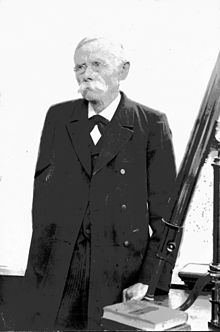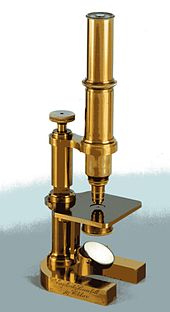Carl Zeiss Sports Optics
| Carl Zeiss Sports Optics
|
|
|---|---|
| legal form | GmbH |
| founding | 2006 |
| Seat | Wetzlar , Germany |
| management | Managing director : Winfried Scherle |
| Number of employees | approx. 600 (2006) |
| sales | Not specified |
| Branch | Long-range optics for hunting, sport, animal and nature observation |
| Website | www.zeiss.de/sportsoptics |
The Carl Zeiss Sports Optics GmbH in Wetzlar is a leading global manufacturer of binoculars , riflescopes and spotting scopes . It is a subsidiary of Carl Zeiss AG. The predecessor company, Hensoldt AG, was one of the industrial pillars of the optical and precision engineering industry in Wetzlar (location 50 ° 33 ′ 39.6 ″ N , 8 ° 30 ′ 1.6 ″ E ). The company has a second production plant in Mateszalka ( Hungary ). The products are sold worldwide through some of their own specialist dealers.
history
On April 15, 1847, the precision mechanic and optician Moritz Carl Hensoldt founded an optical workshop in Sonneberg . According to older information, the founding date of the later Hensoldt AG is 1852. Together with a cousin of his wife, the mechanic and optician Louis Engelbert , Hensoldt built microscopes in Braunfels from 1861 under the name Engelbert & Hensoldt , which soon made a name for themselves. At the end of 1865 the company moved to Wetzlar . In 1896 Moritz Hensoldt's sons Waldemar and Carl became partners in the optical workshops M. Hensoldt & Sons . The company founder died in 1903. In 1922 the company was converted into a stock corporation and was henceforth called M. Hensoldt & Söhne Optische Werke AG . In 1928 the Carl Zeiss Foundation took over a majority stake.
Based on earlier ideas from Ernst Abbe , the Carl Zeiss Jena company began building prism binoculars in 1894. Carl Zeiss became the world's leading company for civil and military optics. In 1945 the Americans took leading employees with them to the West, who founded a new company in Oberkochen . At first, binoculars and riflescopes were developed and manufactured in Oberkochen as well as in Wetzlar , and since 1964 production has been brought together in Wetzlar. Since then they have only been called Zeiss. On October 1, 2006, Hensoldt AG was renamed Carl Zeiss Sports Optics GmbH.
The manufacture and development of military optics, which was also based in Wetzlar , was combined in Carl Zeiss Optronics. At the end of the 2011/12 financial year, the majority of this was taken over by EADS GmbH and operated under the name Cassidian Optronics within the Airbus Group .
Product history
Hensoldt
In the early years the Engelbert & Hensoldt company mainly manufactured microscopes . Moritz Hensoldt began building telescopes in 1877. A scale rangefinder was developed as a military product in 1879. From 1880 the company initially supplied the British and later the German army. In addition to telescopes and binocles (double telescopes) for military, private and hunting use, astronomical telescopes and measuring instruments were manufactured. In 1880 an orthoscopic eyepiece was produced , a further development of the eyepiece by Moritz Hendoldt's friend Carl Kellner . A basic rangefinder followed in 1892/93.
In 1897 the first binoculars in the world with five-sided roof prisms ( Penta 7x29, Model A ) were launched. This double telescope generated a so-called “still image” through two reflections and allowed the use of large, bright lenses.
The first rifle scope from M. Hensoldt & Söhne with a prism erecting system was presented in 1902. The newly designed roof prisms, used here for the first time, enabled a straight axis beam without parallel displacement . Around 1900 Hensoldt was the only manufacturer who mastered the series production of precisely machined roof prisms. The special prism construction of the riflescope was later successfully used in the prism telescope, the Hensoldt Dialyt, developed by Hensoldt's youngest son Carl from 1906 .
Carl Zeiss
In 1893 a patent was filed for a "double telescope with increased lens distance". From 1919 the wide-angle eyepieces developed by Zeiss designer Heinrich Erfle were used in binoculars. In 1933, von Hensoldt - now taken over by Zeiss - began using light metals to replace brass and zinc in case construction. Two years later, the production of binoculars with the anti-reflective T-coating from Zeiss began. The light transmission could be increased by up to 50%.
The first notable innovation after the Second World War was the use of telephoto lenses to reduce the height of binoculars (1954). From 1956 movable rubber sleeve seals were built into center drive models to seal them against moisture . Two years later, the long viewing distance B binoculars were introduced. The "B" stands for "usable for glasses wearers".
A pioneering step for the appearance of modern binoculars was the introduction of a new range of Dialyt binoculars in 1964 , which have a straight prism reversing system according to Schmidt. This construction makes slim and small binoculars possible. In 1968 the 8x20 pocket binoculars were launched. Such pocket binoculars were given a central setting a little later (1974) and eyepieces for those who wear glasses .
An improvement in the optical transmission properties and the image contrast could be achieved from 1979 onwards with the T * multi-layer coating (Carl Zeiss T *). The P-Coating was developed in 1988; it can also reduce interference effects due to phase shifts during image reversal.
In 1982 an aspherical mirror lens was introduced, which made it possible to shorten the length of spotting scopes . In 1990 Hensoldt brought the world's first binoculars ( 20 × 60 S ) with mechanical image stabilization onto the market. In the same year a new range of binoculars and pocket binoculars was launched ( DesignSelection ). In 1994 , the DesignSelection series was followed by monocular night vision binoculars with 20,000-fold light amplification ( 5.6x60 N ). Diafun® binoculars were (from 1997) intended for sports and leisure applications.
For the Victory binoculars, the "Advanced Optics System (AOS)" was introduced in 2000, which uses particularly thin lenses in the objective. The Diascope 65 T * FL and 85 T * FL spotting scopes with fluoride-containing lenses were launched in 2001. FL glasses facilitate the construction of apochomatic objectives that simultaneously focus the light of three wavelengths exactly. This increases brilliance and sharpness. In 2004, fluoride-containing glass was first used in binoculars ( Victory FL series). Shortly before, the Conquest binocular series came onto the market in 2003 .
In addition to well-known products such as binoculars, microscopes and telescopes , epidiascopes , reflex sights and laser range finders are also manufactured.
Carl Zeiss Sports Optics (from 2006)
In the last few years under Carl Zeiss Sports Optics , the LotuTec coating was introduced to protect the outer objective and ocular lenses (2006). The DC4 camera eyepiece, released in the same year, is a digital camera unit in the observation eyepiece. In 2008 the Victory RF binoculars were added with the monocular PRF model . This model has an integrated laser rangefinder and is equipped with a ballistic information system (BIS).
Since 2012 there has been a new generation of Zeiss Victory binoculars with increased optical transmission. As a first step, the Victory FL binoculars with a 42 mm objective diameter were replaced by the new Zeiss Victory HT (High Transmission) 8x42 and 10x42. The first two binoculars in the Victory SF (“Smart Focus”) series followed in 2014, with wide-angle fields of view and special ergonomics aimed specifically at ornithologists. In addition, Zeiss developed the Conquest HD line, which is priced well below the level of the Victory models.
literature
- Hans T. Seeger: Zeiss binoculars. Hand-held binoculars from 1894–1919, models - features - myth. Volume 1, HT Seeger, Hamburg 2010, ISBN 978-3-00-031440-7 .
- Hans T. Seeger: Zeiss binoculars. Hand-held binoculars from 1919–1946, models - features - myth. Volume 2, HT Seeger, Hamburg 2015, ISBN 978-3-00-049464-2 .
- Karsten Porezag: Family and founding history until 1903. (= Hensoldt. History of an optical factory in Wetzlar. Volume 1). K. Porezag, Wetzlar 2001, ISBN 3-9807950-0-4 .
- Edith Hellmuth, Wolfgang Mühlfriedel: Zeiss 1846–1905. From a workshop for mechanics to a leading company in optical device construction. (= Carl Zeiss. The history of a company. Volume 1). Böhlau, Weimar u. a. 1996, ISBN 3-412-05696-0 , pp. 220-228.
- Hans T. Seeger: binoculars. Binoculars through the ages. Bresser-Optik, Borken 1989.
- Ernst Voege: 100 years of M. Hensoldt & Sons. Optical Works AG Wetzlar. Hoppenstedts Wirtschafts-Archiv, Darmstadt 1952.
- Carl Hensoldt: The Hensoldt factory and its relationship to general telescope technology. o. A., Wetzlar 1908.
Web links
- Company website
- Descriptions of older Zeiss binoculars in the Virtual Museum of the Carl Zeiss Archive
Individual evidence
- ↑ For the founding history of the Hensoldt company see in great detail: Karsten Porezag: Family and founding history until 1903 (= Hensoldt. History of an optical factory in Wetzlar. Volume 1). K. Porezag, Wetzlar 2001, ISBN 3-9807950-0-4 .
- ↑ See: Ernst Voege: 100 years of M. Hensoldt & Sons. Optical Works AG Wetzlar. Hoppenstedts Wirtschafts-Archiv, Darmstadt 1952, p. 28 ff.
- ↑ On the corporate history of Carl Zeiss see: Wolfgang Mühlfriedel, Rolf Walter (Ed.): Carl Zeiss. The story of a company. Volume 1-3.
- ↑ For the history of binoculars at Carl Zeiss see: Edith Hellmuth, Wolfgang Mühlfriedel: Zeiss 1846–1905. From a workshop for mechanics to a leading company in optical device construction. (= Carl Zeiss. The history of a company. Volume 1). Böhlau, Weimar et al. 1996, ISBN 3-412-05696-0 , pp. 220–228.
- ↑ For the separation see: Stephan Paetrow: ... what belongs together. 20 years of reunification of Carl Zeiss. Hanseatischer Merkur, Hamburg 2011, ISBN 978-3-922857-51-8 , pp. 9-14.
- ↑ bundeswehr journal: Cassidian Optronics now a 100 percent Airbus subsidiary, accessed on November 13, 2014.
- ^ Museum of Optical Instruments, Timo Mappes, Karlsruhe .
- ↑ For the early products of Hensoldt see: Carl Hensoldt: Das Hensoldt-Werk and its relationship to general telescope technology. oA, Wetzlar 1908.
- ↑ For the early products from Hensoldt see: Hans T. Seeger: Feldstecher. Binoculars through the ages. Bresser-Optik, Borken 1989.
- ↑ For the early Zeiss binoculars see: Carl Zeiss AG: Virtual Museum accessed on November 17, 2014.
- ↑ For the early Zeiss binoculars see: Hans T. Seeger: Zeiss-Feldstecher. Hand-held binoculars from 1894–1919, models - features - myth. HT Seeger, Hamburg 2010, ISBN 978-3-00-031440-7 .







